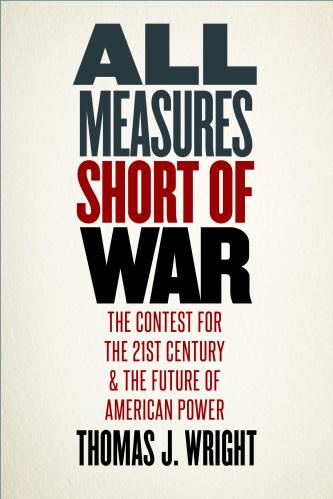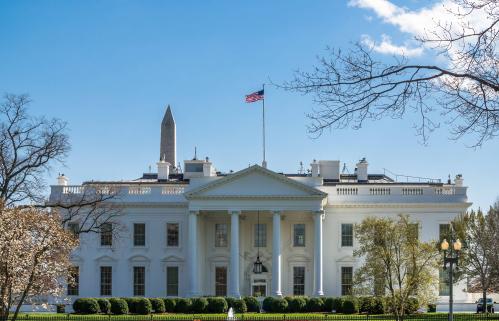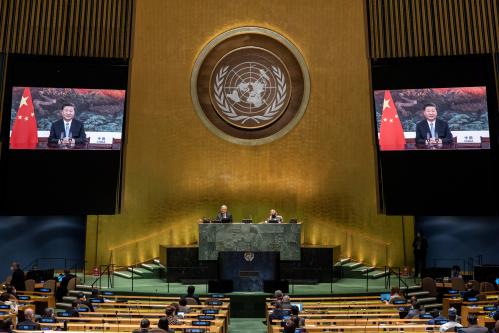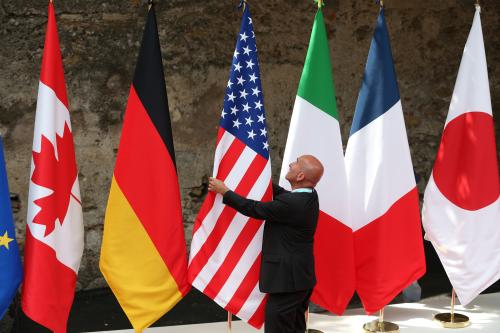To restore the effectiveness of America’s multilateral diplomacy, writes William Burke-White, the United States must recognize and respond to a radically transformed geostrategic environment with a new approach to the multilateral architecture. This piece was originally published by Lawfare.
In his first month in office, President Biden has taken important first steps “to begin restoring American engagement internationally and earn back our leadership position, to catalyze global action on shared challenges.” The new administration has rejoined the Paris Agreement, reengaged the World Health Organization, returned (as observers) to the U.N. Human Rights Council and reached an agreement with Russia on the extension of the New START Treaty.
The Biden team should be lauded for these quick moves. While these moves are both symbolic and substantive, they are not sufficient to achieve Biden’s goal of “repair[ing] our alliances and engag[ing] with the world once again, not to meet yesterday’s challenges, but today’s and tomorrow’s.” To restore the effectiveness of America’s multilateral diplomacy, the United States must recognize and respond to a radically transformed geostrategic environment with a new approach to the multilateral architecture — the array of international institutions and international legal commitments that structure cooperation and competition with other countries.
The world Biden inherited is not that of President Obama in 2009, much less that of President Clinton in 1993. Three significant shifts have altered the geostrategic context. First, despite the fact that the United States served as the primary architect of the international institutional order some 75 years ago, today it is as a relative outsider in the multilateral policy space. Under the Trump administration, the United States exited numerous international organizations, stepped back from leadership roles and withdrew from significant international legal commitments. These exits include, to name but a few, the U.N. Human Rights Council, the World Health Organization, the U.N. Economic Social and Cultural Organization, the Paris climate accord, the Trans-Pacific Partnership, the Open Skies Treaty, the Intermediate-Range Nuclear Forces Treaty and the Global Compact on Migration. As the United States has retreated over the past four years, its allies and adversaries alike have doubted, questioned and even challenged its leadership. President Biden’s quick reversal of some of these exits does not change the broader trend, nor the world’s perception thereof.
Second, China has fully emerged as a rival in multilateral affairs. Under President Xi Jinping, China has meaningfully enhanced its prominence in the multilateral system both by virtue of its increasing geopolitical power and by its strategic efforts to set the agenda within multilateral institutions. Chinese nationals now lead four of the 15 U.N. specialized agencies — far more than any other country. China is actively asserting its newfound influence to steer multilateral institutions toward its own interests. The vast financial commitment of the Belt and Road Initiative has given China significant new leverage over individual countries across the globe. It is now demonstrating a willingness to tie these financial commitments to support in multilateral policy settings. China’s expanding leadership sends a powerful signal to the world that its position and interests must be respected, even if at the United States’s expense.
Third, multilateral policy has become politically divisive at home. For most of the past 75 years, the basic U.S. commitment to the international order has stood strong. Today, however, the United States finds itself deeply divided as to whether leadership of the international order remains in the U.S. national interest. Growing skepticism of international institutions and commitments in both political parties will require the new administration to carefully steward limited political capital. Notwithstanding the incoherence of Trump’s “America First” foreign policy, it created political space within the Republican Party to question the value of international institutions, the utility of multilateral policy and the benefits of a global order. Within the Democratic Party, populist and progressive voices alike are questioning the alignment of the international order with Americans’ values and interests.
This altered landscape demands a new approach, including decisive shifts in the strategy and tactics the U.S. employs in the international institutional system. A new set of principles — not just a few announcements of reentries — must guide America’s multilateral strategy in this new era. Dubbed “The Philadelphia Principles” — drawing on Ben Franklin’s legacy (after all, President Biden was the Benjamin Franklin Presidential Professor at Penn) — these principles offer new ways to frame U.S. multilateral efforts at the global level, among our partners and allies, and in our own domestic and bureaucratic politics. (You can read the principles here.) Collectively, they position the United States to better advance core interests through the tools of multilateralism in a competitive geostrategic environment.
First, at the global level, the multilateral order is now defined by great power competition, especially with China. China’s far more assertive approach in multilateral institutions and its quest for leadership roles within those institutions will accelerate. For the United States to effectively advance its own interests in this context, it too must be willing to compete in multilateral settings. The United States must be vigilant of and prepared to check competitors’ efforts to alter norms or assert authority within the full range of multilateral institutions, including less prominent ones. It must develop new approaches to working with competitors where interests align, without being seduced into believing the international environment is fundamentally one of cooperation. Negotiating a revised version of the Trans-Pacific Partnership that advances the economic interests of Americans and eventually ratifying the U.N. Convention on the Law of the Sea must be centerpieces of an effort to check China’s regional and global economic ambitions.
Second, addressing transnational threats, especially climate change, must be a fundamental goal of U.S. multilateral strategy. Climate change, unregulated human movement, and pandemic disease present growing and potentially existential threats to the United States and the globe. Multilateral policy coordination is indispensable to any effective approaches to mitigating, managing and preventing these threats. While bearing in mind the environment of great power competition in which multilateral policy now operates, the United States must focus its multilateral efforts to an ever-greater degree on collective global responses to transnational threats. Such efforts must establish and affirm basic norms and rules to govern transnational issues, encourage deeper commitment and compliance by broad coalitions of states, and strengthen institutional architectures for implementation, monitoring and enforcement. Specifically, the U.S. must truly recommit to the U.N. Framework Convention on Climate Change (UNFCCC) and drive the reform of the World Health Organization.
Third, in working with allies and partners, multilateral engagement should start with countries that share the United States’s values and commitment to democracy. In building coalitions, establishing cooperation, or designing club governance models, U.S. multilateralism must begin with a shared commitment to a core set of common values, including democratic governance and human rights. Building coalitions of states that share these values is ultimately the best way to confront great power rivals. Groups of states bound together by shared values and commitments to democratic governance may also be able to build redundancies into the international institutional architecture to step in where universal institutions are gridlocked or ineffective. In restoring its commitment to rights and democracy, the United States also clearly signals to the global community that it lives by the values it expects of its partners, thereby enhancing its credibility at a time when U.S. reliability is in doubt. The U.S. should begin this effort through tangible human rights and racial justice commitments at home while reflecting these values internationally.
Fourth, successful multilateralism requires the strategic use of multiple institutions, including informal processes, club models and nonbinding commitments. Where traditional institutions appear ineffective due to political gridlock, lack of policy consensus, and the growing influence of U.S. rivals, the United States must be ready to turn to or even build new institutional structures, just as U.S. rivals have done. For any given issue, the United States must carefully and strategically select the institution(s) most likely to be effective in the context of great power rivalry and work across multiple institutions simultaneously. The United States should also become a leader in the establishment and operation of club-model governance structures, particularly in the climate space, where they can offer promising ways of managing limited public goods resources in a competitive environment.
Fifth, in U.S. domestic politics and bureaucratic processes, multilateral policy must be better integrated into global diplomatic strategy. Within the U.S. government, multilateral policy has long operated in its own bureaucratic and diplomatic silo, walled off from and usually secondary to bilateral diplomacy. In today’s more competitive global landscape, effective multilateralism requires deeper integration of these two co-equal pillars of diplomacy. While the United States should not adopt China’s transactional approach to these linkages, it must be prepared to respond when competitors make explicit bargains that leverage bilateral and multilateral diplomacy. Bureaucratic reforms must be undertaken at the Department of State and the National Security Council to better align the two pillars of U.S. diplomacy.
Sixth, multilateral objectives must align with the interests of the American people and the values the United States seeks to embody at home. Fundamentally, the purpose of multilateralism must be to advance the interests of the American people, yet economic and political shifts of past decades have led many Americans, particularly the middle class, to question the value of the international order. To restore the confidence of the American people in multilateralism, the U.S. government must better understand the interests of the majority of the American people and ensure that the U.S. multilateral agenda aligns with those interests. So too, the U.S. government must better communicate how multilateral leadership and international institutional engagement make America safer, stronger and more prosperous.
The Philadelphia Principles offer a road map for a new U.S. approach to multilateralism that responds to a starkly altered geopolitical landscape. The Biden administration must quickly move beyond the relatively easy institutional reentries of the first month toward the far more challenging reform of multilateral architecture such that it better serves the interests of the American people. The Philadelphia Principles can provide a touchstone along this difficult but indispensable journey.
The Brookings Institution is committed to quality, independence, and impact.
We are supported by a diverse array of funders. In line with our values and policies, each Brookings publication represents the sole views of its author(s).










Commentary
A new geostrategic environment demands new principles for US multilateral diplomacy
February 25, 2021